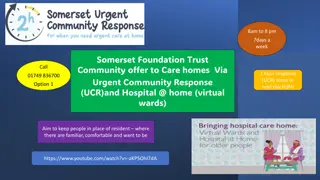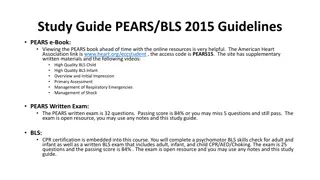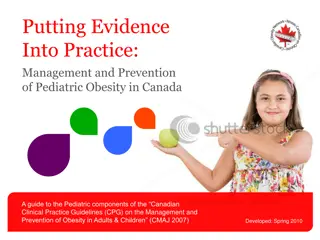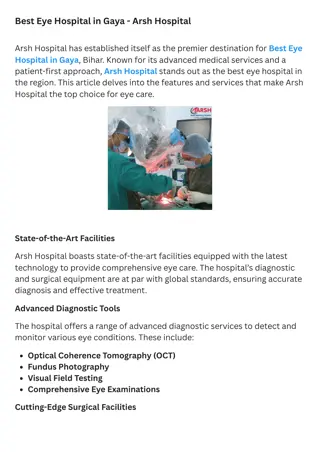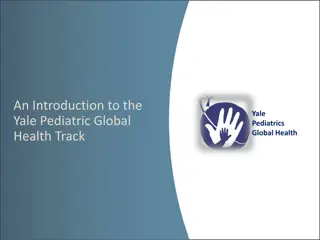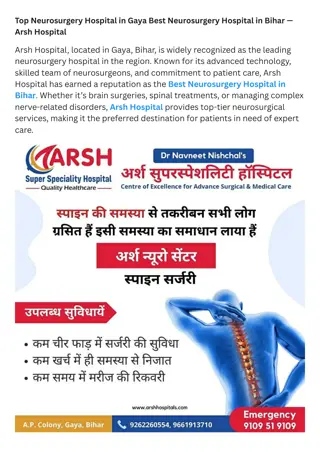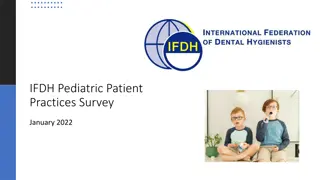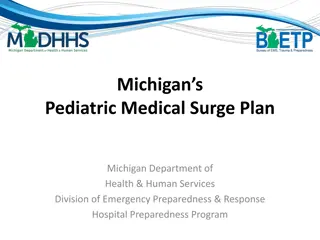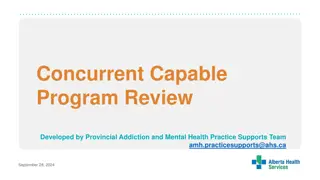Pediatric Concurrent Care: Enhancing Support Through Hospital Teams
Gain insights into pediatric concurrent care at Seattle Children's Hospital with Sue Ehling ARNP and Anne Anderson RN. Discover the importance of connecting with hospital teams for improved communication and support. Learn from a case study and lessons learned to enhance care for young patients facing challenging medical circumstances. Explore tips, tools, and resources available for providing concurrent care in pediatric settings.
Download Presentation

Please find below an Image/Link to download the presentation.
The content on the website is provided AS IS for your information and personal use only. It may not be sold, licensed, or shared on other websites without obtaining consent from the author.If you encounter any issues during the download, it is possible that the publisher has removed the file from their server.
You are allowed to download the files provided on this website for personal or commercial use, subject to the condition that they are used lawfully. All files are the property of their respective owners.
The content on the website is provided AS IS for your information and personal use only. It may not be sold, licensed, or shared on other websites without obtaining consent from the author.
E N D
Presentation Transcript
Seattle Childrens Hospital Sue Ehling ARNP & Anne Anderson RN HOSPICE CONCURRENT CARE: HOW TO USE YOUR HOSPITAL TEAMS FOR SUPPORT
HOPES FOR TODAY.. Gain understanding of pediatric concurrent care Understand how connecting with your hospital teams improves communication and increases support to family and your hospice team Review challenges to providing concurrent care Review tips, tools and resources available
Before Concurrent Care: Case Study Shelley was 17yo young women with recurrent metastatic osteosarcoma. She received conventional treatment, second and third line therapy prior to a phase 1 study. She had progression of her disease after two courses of the study and opted to go home without further cancer directed therapy. Being home with friends is important to teens, and she chose to stop treatment in order to be home. It was difficult to find a hospice agency to accept her care, because she had renal insufficiency and required overnight hydration.
Lessons Learned from Shelley.. Shelley would have benefited from Concurrent Care. She wouldn t have had to choose between treatment and hospice. Listen to what is important to teens. Shelley had a lot of pain and needed IV opiods, but adamantly refused a continuous infusion. She wanted to go to school, make prom plans, etc. She only would do bolus dilaudid Giving her TPN was the right thing to do to extend her life. If she came off she would have died quickly from hypokalemia. She is a great example of adolescent invincibility.
Oncology Team Pearls from Experience with Kids with Uncertain Prognosis Metastatic sarcoma < 20% overall survival. These patients get an upfront palliative care referral. This process is normalized as happening for all metastatic patients. At first recurrence, refer to palliative care Refer early to community palliative care or hospice How do we sell hospice? Our community partners, our eyes and ears in your home, our partners that allow us to give you quality time at home
Relationship Between Providers and Hospice Pediatric providers stay involved Preference to discuss patient and family prior to first visit in the home to get medical background as well as social dynamics. Also, to get details of how we introduced the hospice team. If family particularly is worried about referral, RN to call provider from visit. Calls from home work very well for symptom management, and to feel connected with their providers. Friday check in to establish guidelines for weekend pain escalation.
Concurrent Care A different paradigm for pediatric hospice
What is Concurrent Care? Pediatric Concurrent Care is a provision of the Affordable Care Act. Benefit for children with MEDICAID, private insurances may consider carving out some things from hospice benefit. Children can CONCURRENTLY receive hospice and life prolonging or curative treatments.
Concurrent Care can be perplexing. Why do they want to go to the ED or hospital? Why is this patient receiving chemo, radiation, or transfusions on hospice? What happens if the patient goes into the hospital? How do we know what is covered by hospice? How do we address goals of care when everything is an option?
Infant Considerations Prognosis may be unclear. Avoid terms like fatal or not compatible with life. Supplies needed could include newborn sized diapers and feeding tubes. DME could include a breast pump. What other services would enhance quality of life? Birth to three? Partnerships with community supports like WIC and Public Health Nurses can increase support to family. Is it time to suggest having further medical evaluations done?
What we have learned, so far.. Children may stay on hospice longer. Scope of care feels more like palliative care in a broad sense than hospice. Families may want to use an alternative name to describe the support. Concurrent Care My Home Team Hospices need support in understanding this paradigm. Reach out to Medicaid plan with questions. Communication is important, especially with after hours staff. Errors can happen when the label of hospice is over interpreted.
Medicaid Managed Care Resources Molina: Cathi Spears 425-424-7148 United Healthcare: Cindy Spain 206-992- 0222 Coordinated Care: Marilyn Lowery 253-442- 1515 Amerigroup: Tonya Niverson 206-695-7081 ext 1061245005 At state level: Nancy Hite 360-725-1611
First Visit Etiquette for Success If a child comes home without a POLST, do not address it on the first visit, maybe never. Sign consents, but don t overwhelm the family with details Don t worry about checking all the boxes. Funeral planning can wait, perhaps until after death. Use words like an extra layer of support or advocacy to describe how you might help Ask what their child knows about their illness Ask what the siblings know Follow the family s lead in words they use
How to learn a familys story. 1. Tell us about your child, what is s/he like as a person? 2. What is your understanding of your child s illness? 3. In light of your understanding, what s most important to you? 4. What are your hoping for? What are your worries? 5. How do you maintain your strength?
Hints for Success: Clinically JOINT VISITS! RN and Chaplain or RN and Social Work Utilize pediatric providers, to get history prior to meeting family and to find out how they have introduced hospice. Keep them informed with calls from home. Start slowly....offer hospice aide for manicure or chaplain to read with child. Less hands on assessment initially. Use your eyes and ears. Have cultural curiosity. USE INTERPRETERS! Introduce bereavement staff early. Reach out to medical examiner or EMS providers.
Hints for Success: Child/Family Focus Focus on what is important for child and their entire family. Remember kids have big communities. Allow child and family to have hope and know that the meaning of hope will most likely change. Attend to siblings. Keep bubbles, pipe cleaners, playdoh in your bag or car. Use interpreters! Do not use siblings except in an emergency. Prepare child and family for disease progression. Keep the providers in the loop.
Pediatric Differences Methadone is the only liquid medication for long acting opiod use. For Oncology patients Tylenol two doses per day. No ibuprofen. With fever go to ED, especially if they have a central line, unless family has clear goals to be home regardless of medical situation. No rectal medications
Norms/Challenges with Feeds/Fluids Many medically complex children receive chronic enteral (NG or G-tube) feeds Respect societal, cultural, religious beliefs around feeding Weight gain or maintaining weight is often major focus during treatment phase Letting go of feeds can be VERY emotionally challenging Anticipatory guidance helpful: discuss symptoms that would make you want to consider decreasing feeds Often slow/titrate down Feedings/fluids can worsen condition, especially respiratory symptoms
Explore the Patient and Familys Goals for Pain Management To be pain-free (or as close to it as possible) or To have optimal function with minimal discomfort or To have minimal, if any, side effects from medications or To be able to interact at a desirable level, so other important things can be prioritized, whether that is going to school or work, even if it means living with pain
Case Study: Listen to the Patient The Teams Wishes May Not Be Right Troy was a 19 year old with Ewings Sarcoma who had lung recurrent at 9 months off therapy. He was very clear he would never stop receiving therapy. He received 2ndline, 3rdline, clinical trial and then 4thline therapy. During his 4thline therapy he refused to have restaging scans because it didn t help him make decisions. During his 4thline therapy he decided to get a job! AND he wouldn t tell his employer he had cancer since he wanted to be treated like everyone else.
Pediatric Palliative Care in Washington State *Hospice Concurrent Care with Medicaid *Hospice care with private insurance *Some agencies provide pediatric palliative care through a home health benefit. *Hospices can provide support with the WA State Medicaid Pediatric Palliative Care benefit: up to 6 visits per month for RN and MSW. Two hours of case management can be billed as a visit. *Hospital based programs at Seattle Children s, Mary Bridge in Tacoma and Sacred Heart in Spokane.
Role of Hope.... Denial vs Extreme Hope I know you are hoping your disease will be cured. Are there other things you are hoping for? I m going to hope along with you
The Complexity of Hope Some families report a harmonious relationship, they can hear bad news and hold onto hope at the same time. Study from Boston reported that increased prognostic disclosure led to: Decreased distress about prognosis Higher levels of communication-related hope Higher levels of trust in the physician Chris Feudtner from CHOP calls it regoaling hope shifts away from cure or long life to comfort or peace. Mack 2007, Hauer 2013, Curtis 2008
Hope is not the conviction that something will turn out well, but the certainty that something makes sense, regardless of how it turns out Vaclav Havel
HELPFUL RESOURCES Pediatric Pain and Symptom management Guidelines from Dana Farber http://pinkbook.dfci.org/assets/docs/bl ueBook.pdf CHIPPS newsletter https://www.nhpco.org/chipps-e-journal Pediatric Grief Support https://washington.providence.org/- /media/files/washington/services/understand- and-help-the-grieving-child.pdf?la=en courageousparents.org partnershipforparents.com
QUESTIONS/HELP Anne Anderson 206-987-5579 anne.anderson@seattlechildrens.org Sue Ehling susan.ehling@seattlechildrens.org 24/7 Access to Seattle Children s Palliative Care Attending through the paging operator, 206-987-2000
Far and away the best prize that life has to offer is the chance to work hard at work worth doing. --Theodore Roosevelt




